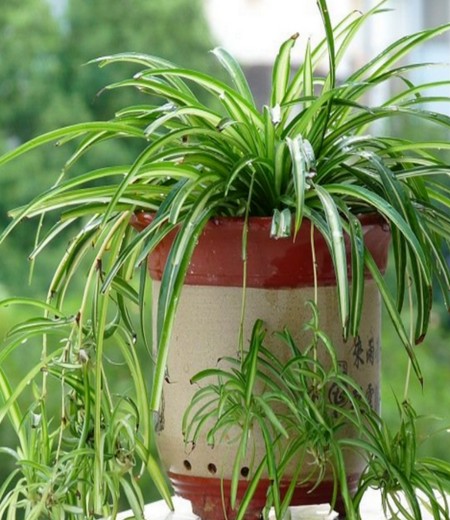Grafting cultivation methods and precautions of chrysanthemum
Dutch chrysanthemum flowers are colorful and adaptable, especially the new varieties introduced in recent years. The plants are shorter and naturally formed. The flowering season is around the National Day. Therefore, they are mostly used as flower beds and flower border materials. They can also be planted in pieces, in groups, or as potted flowers or cut flowers.
The effect of grafting cultivation of chrysanthemum with wild Artemisia annua L. as rootstock is better. The specific methods are as follows:
At the end of November or early December, the flowers are picked and the pots are turned over for soil replacement. When the outdoor temperature drops to about 5 ° C, the pot is moved into a low-temperature greenhouse, and it is not allowed to enter a medium-temperature or high-temperature room, so as to avoid sprouting and making chrysanthemum seedlings vulnerable to wind.
After the beginning of spring in the following year, the potted chrysanthemum will be moved to an outdoor shelter, and some thin fertilizer water such as human excrement will be poured around Qingming Festival. Digging Artemisia annua seedlings from the field from the end of April to the end of June, planting them in mud pots with a diameter of 5 inches or 7 inches, changing them into 8-10 inches mud pots according to the growth size of Artemisia annua plants in June and July, and applying thin fertilizer water once every 5 days.
When the stem height of Artemisia annua reaches 15 cm, it can be grafted by cleavage method, and after grafting, it can be covered with small plastic bags to keep moisture, and it can survive for about 7 days. It should be noted that the height of the rootstock is about 15 cm. If it is 20 cm higher, the later stage of the chrysanthemum will have a top-heavy and unstable feeling.
Secondly, if the inner core of the grafting mouth of Artemisia annua rootstock has been white and aged, it is not suitable for grafting, because it is not easy to survive after grafting, and even if it survives, it will make the scion rigid and not hair.
After the Dutch chrysanthemum grafting survives, thin fertilizer can be applied frequently, and management is like cultivating autumn chrysanthemum. At ordinary times, the directional core removal of Dutch chrysanthemum can be carried out according to the shape of spherical, flat steamed bread, etc., but the last core removal needs to be carried out simultaneously for each head. If you need to bloom on National Day, you can pick the core for the last time in the summer (early July). If you need to bloom in autumn chrysanthemum exhibition, you can pick the core for the last time in late July. After examination, the diameter of the largest sphere formed by the grafted seedlings of chrysanthemum trees can reach about 35 cm, which is very spectacular.
Dutch chrysanthemum is capitate, dense, florescence 8-9 months, color has blue, purple, red, white and so on. Commonly used seeding, cuttings and sub-propagation. Sowing in spring in April, germination 12-14 days after sowing, but good varieties are easy to degenerate. Cuttings are carried out in spring and summer, and tender stems are cut for cuttings. Root formation occurs 18-20 days after insertion. The ramet can be carried out in spring and autumn, generally once every three years.
In order to make the plant type plump and the flowers colorful, attention should be paid to:
1, timely pruning and topping. Chrysanthemum is a pruning tolerant plant, which can be promoted to bloom by picking and pruning.
2. Fertilization and watering. Before planting, apply enough basal fertilizer, and apply thin cake fertilizer every 2 weeks during the growth period to promote vigorous growth. At the same time, water as appropriate, and water in time when the weather is dry.
3, in the cultivation of pests and diseases found in a timely manner to spray pesticides. Dutch chrysanthemum is generally susceptible to powdery mildew, planting should not be too dense, pay attention to control humidity and ventilation, once found infected to spray chemicals in time.
Time: 2019-06-11 Click:
- Prev

Potted chrysanthemum propagation method
Mid-autumn season, small garden inside the Dutch chrysanthemum competition open, a cluster of fresh romantic. Dutch chrysanthemum, also known as willow chrysanthemum, New York aster, Aster Compositae perennial root herbs, flowers delicate shape, colorful gorgeous, chrysanthemum is a very lovely variety
- Next

Propagation method of Cymbidium
Cymbidium can be propagated by cutting, ramet, sowing and other methods. Cutting and ramet propagation can be carried out at any time from spring to autumn. Cymbidium has strong adaptability and high survival rate, so it is generally easy to reproduce. When cutting, as long as the stolon with new buds is 5-10 cm into the soil, it will take about a week to root.
Related
- Fuxing push coffee new agricultural production and marketing class: lack of small-scale processing plants
- Jujube rice field leisure farm deep ploughing Yilan for five years to create a space for organic food and play
- Nongyu Farm-A trial of organic papaya for brave women with advanced technology
- Four points for attention in the prevention and control of diseases and insect pests of edible fungi
- How to add nutrient solution to Edible Fungi
- Is there any good way to control edible fungus mites?
- Open Inoculation Technology of Edible Fungi
- Is there any clever way to use fertilizer for edible fungus in winter?
- What agents are used to kill the pathogens of edible fungi in the mushroom shed?
- Rapid drying of Edible Fungi

